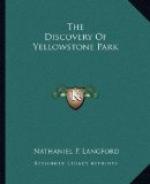Jake Smith stood guard last night, or ought to have done so, and but for the fact that Gillette was also on guard, I should not have had an undisturbed sleep. We know that the Indians are near us, and sleep is more refreshing to me when I feel assured that I will not be joined in my slumbers by those who are assigned for watchful guard duty.
[Illustration: S.T. Hauser]
Friday, August 26.—For some reason we did not leave camp till 11 o’clock a.m. We forded Gardiner’s river with some difficulty, several of our pack animals being nearly carried off their feet by the torrent. We passed over several rocky ridges or points coming down from the mountain, and at one and a half miles came down again into the valley, which one of our party called the “Valley of desolation.” Taking the trail upon the left, we followed it until it led us to the mouth of a canon, through which ran an old Indian or game trail, which was hardly discernible, and had evidently been long abandoned. Retracing our steps for a quarter of a mile, and taking a cut-off through the sage brush, we followed another trail upon our right up through a steep, dry coulee. From the head of the coulee we went through fallen timber over a burnt and rocky road, our progress being very slow. A great many of the packs came off our horses or became loosened, necessitating frequent haltings for their readjustment. Upon the summit we found a great many shells. Descending the divide we found upon the trail the carcass of an antelope which the advance party had killed, and which we packed on our horses and carried to our night camp. In the morning Lieutenant Doane and one of his men, together with Mr. Everts, had started out ahead of the party to search out the best trail. At 3 o’clock p.m. we arrived at Antelope creek, only six miles from our morning camp, where we concluded to halt. On the trail which we were following there were no tracks except those of unshod ponies; and, as our horses were all shod, it was evident that Lieutenant Doane and the advance party had descended the mountain by some other trail than that which we were following. Neither were there any marks of dragging lodge poles. There are seemingly two trails across the mountain,—a circuitous one by as easy a grade as can be found, over which the Indians send their families with their heavily laden pack horses; and a more direct, though more difficult, route which the war parties use in making their rapid rides. This last is the one we have taken, and the advance party has doubtless taken the other.




